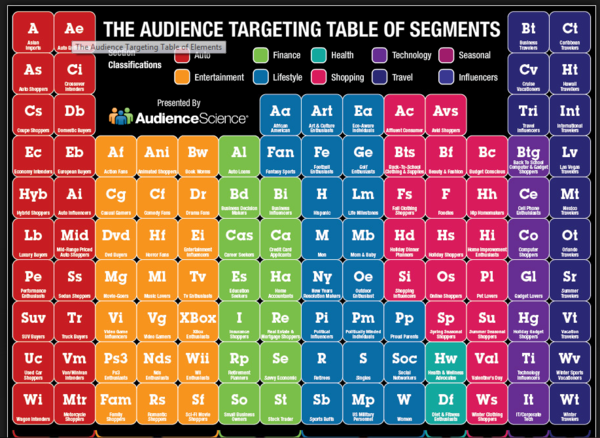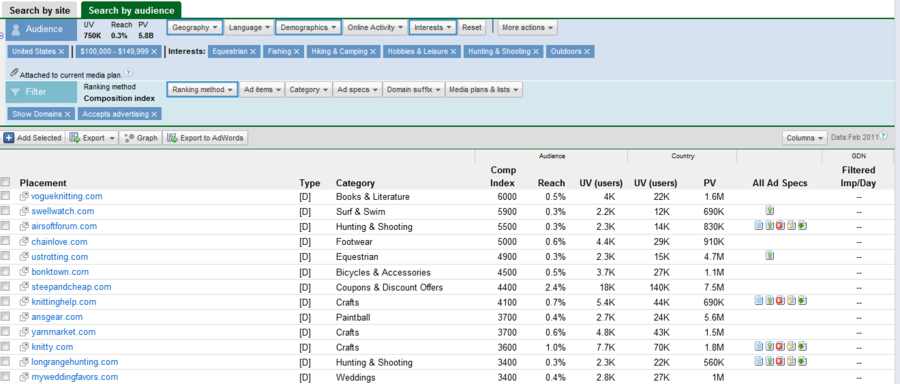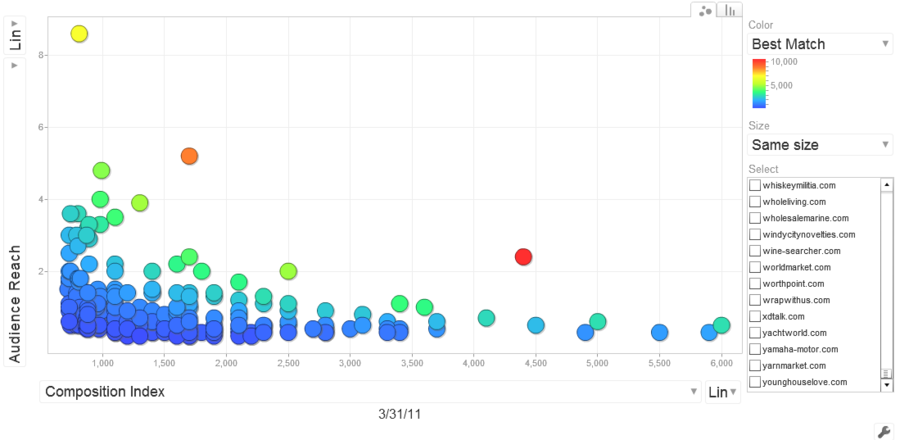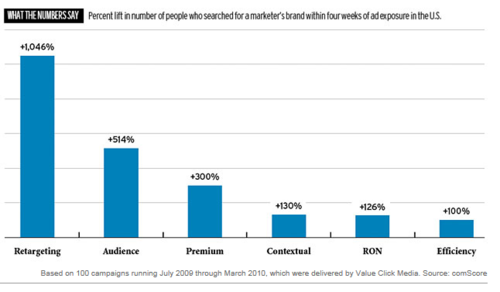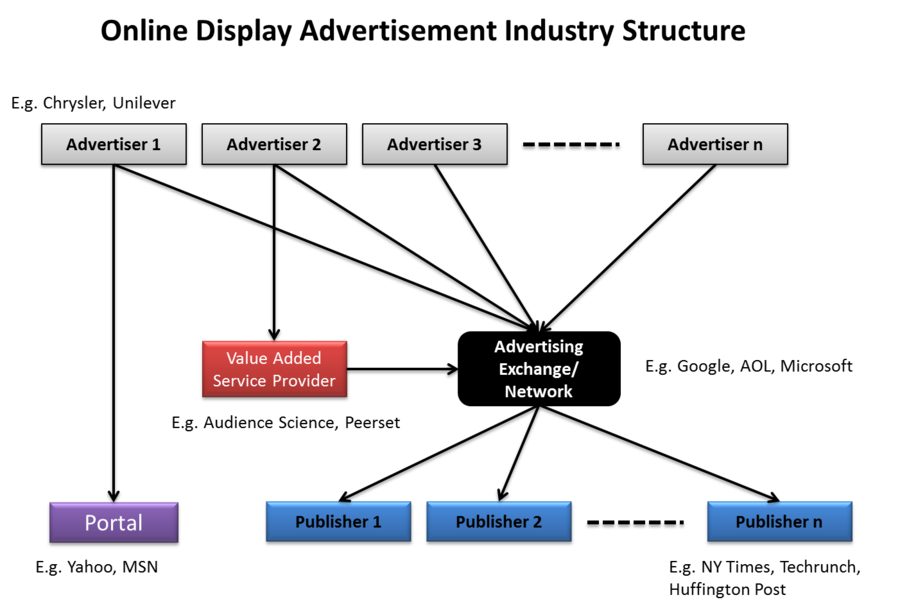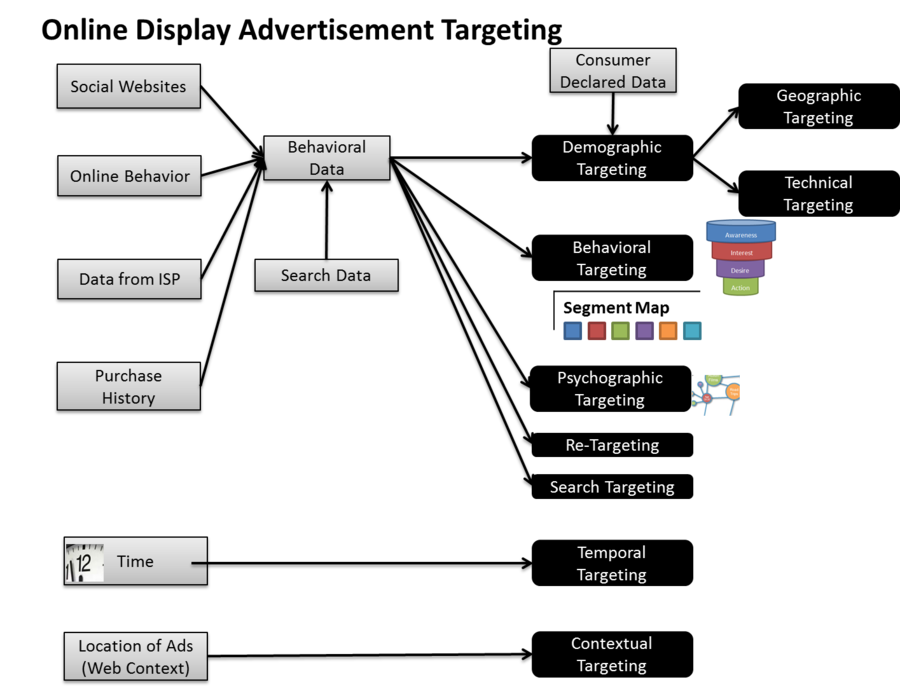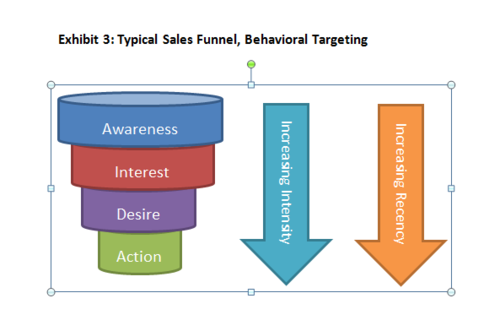Display Ad Targeting
From The Yaffe Center
INTRODUCTION
The online display advertising industry has been transformed from a simple relationship between advertisers and publishers to a complex industry structure with three key players: advertisers, publishers, ad networks and value added service providers. (Refer Exhibit 1 in the appendix)
Today’s brand marketing managers need to have a good understanding of the tools/ services provided by ad networks in order to effectively communicate with customers and measure the success of their marketing campaigns. The click through rates for untargeted online advertisements has dropped to below 0.1% of all advertisements served.
Advertiser: Any firm that wants to create and broadcast display ads.
Publishers: A website or portal that sells empty space on their webpages to advertisers. Publishers could be news sites like NY Times.com, Huffington Post, portals like YouTube, individual blogs etc.
Advertising Networks : A broker that helps connect advertisers and publishers in addition to providing advertisers with tools to effectively target and measure the success of their advertising campaigns. The three big players in this space are AOL, Microsoft and Google. Publishers typically sign up with ad networks to sell their inventory (empty space on their webpages to display ads). Advertisers approach advertising networks who in turn work with their network of publishers to display the ads. Value Added Service Providers: Players like BlueKai and Audience Science who collect information on user’s browsing habits and then sell this information to advertisers.
TARGETING METHODOLOGIES
Before the advent of online advertising, advertisers only had access to rudimentary tools that allowed targeting. Most targeting was contextual. For example, a bank would advertise financial instruments in the finance section of a newspaper. This assumes that every reader of the finance section is a potential customer for the product (or at least a big percentage of readers). The key purpose of advertising is to move customers further along the sales funnel. The ROI in the contextual advertising world was hence improved by choosing a context that had the greatest potential to attract customers. A large percentage of contextual advertising expenditure however goes towards exposure to individuals who are within the context but not potential customers. For instance, the advertisement for financial instruments in the finance section is seen by thousands of readers but only a small portion of these are potential customers (Refer Exhibit 3 in the Appendix).The second drawback with contextual advertising is that it does not encompass all potential customers. It becomes costly for advertisers to identify all contexts in which they will find potential customers. A limited exposure to contexts also results in a limited exposure to potential customers. Hence, there clearly is a need for a more effective and cost effective technique of identifying potential customers for advertisements.
Rather than targeting contexts (newspapers, locations, websites etc.) the advertising industry is now moving towards targeting individuals at the right stage along the sales funnel. The internet ecosystem allows companies to collect information about customer’s browsing habits, hypothesize about their tendency to purchase a particular product and serve them with ads. There are a slew of firms who have entered the advertising value chain by collecting, aggregating and selling information that helps advertisers target their potential customers. There are also a set of firms that help advertisers track the success of their online advertising efforts through various metrics.
Methods of Collecting Data: There are two methods that advertising networks use to collect data:
Voluntary disclosure of Data: When a user creates an account to access an online service, the user is asked to provide information that allows the service to uniquely identify the user. The data that is collected is typically voluntarily disclosed by the user: name, age, address, sex, interests etc. This information has traditionally been used to protect the user’s account and target the features of the service to the user. With the rising importance of online advertising this information is now also being used to serve targeted ads to the user. One of the problems with voluntary disclosure is users creating fake profiles. As of today, there aren’t any foolproof methods available to identify these fake profiles.
Browsing Behavior, Cookies: The second method of collecting data is akin to a detective snooping around, collecting data on a user’s online behavior. The cookie was originally invented as a solution to an e-commerce problem so that e-commerce websites could remember the contents in an online shopper’s shopping cart. It has now morphed into a powerful tool for targeted advertising. In the advertising world cookies are managed by an advertising network. An advertising network deploys technology that allows it to add/ track cookies for users across its network of websites. The first time a user visits a member website the ad network ads a cookie onto the user’s machine. Every time the user visits another of the member websites, the ad network uses the original cookie to identify the user and makes an auditing entry against the cookie in servers maintained by the ad network. This allows the ad network to track every move of the user across its website network. A limitation with using cookies to track data is when there are multiple users on the same machine. Cookies do not provide a method to differentiate amongst multiple users using the same machine. With the increasing number of display advertisements being served on smartphones, this issue is diminishing as a threat. An advertising network with a large sized and diverse member network will resultantly collect more high quality data. Hence, while advertisers make a choice amongst the various available advertising networks they should pay close attention to:
1. Size of the network: A network with more websites has access to more “eyeballs” – consumer views
2. Nature of the network: Variety of websites that the network has signed. A network with a wider variety of websites will be able to target a greater variety of consumers. However a finely targeted advertising campaign might require a particular kind of consumer/website. Rightly so, this method of collecting data is both powerful and controversial. There are a lot of energetic discussions between privacy advocates, technology companies and advertising lobbyists in Washington. The legal outcome of these discussions will play a huge part in shaping the future of this industry. (Addressed in this paper in the section on privacy)
Targeting Methodology:
Based on the data collected above, there are 6 widely used methods by advertising networks to target consumers. These methods are not mutually exclusive and marketers should consider using a combination of these techniques to reach their consumers. A marketer reaches out to an advertising network with the desired targeting mechanism and other criteria. The advertising network uses this information provided by the advertiser to make a choice amongst the available inventory from its participating members. Some of the networks also allow advertisers to make specific choices about where they would like their advertisements to be displayed as well as websites where they would never want their advertisements to be displayed.
1. Contextual Targeting: Advertisers target a context rather than targeting an individual. This form of advertising is the least effective in targeting specific consumers but is still widely used because of the simplicity in campaign design. The nature of this form of targeting is no different from contextual advertising used in the physical world by placing ads in a particular magazine, newspaper, location etc. Contextual targeting can be either static or dynamic. A static contextual targeting methodology would involve identifying the context of the ad prior to the actual time the ad is served. For instance, identifying the context for an auto advertisement on Carfax. A dynamic methodology would identify the context at runtime and then display ads to the consumer. For instance, Google uses the dynamic context in a user’s email to target him/ her with contextual text ads.
Marketers should consider this form of advertising when they want to increase general awareness for their products across a wide consumer base. This would typically be in very early stages of the sales funnel.
Usage: An advertiser using this method of targeting would need to define the contexts that they want to target. Once they provide this information to the advertising networks, the networks would decide the publishing contexts where these conditions are satisfied.
2. Demographic Targeting: Advertisers target consumers based on their demographic characteristics like age, geography, sex, household income, language etc. This is the most basic form of targeting individuals and is widely used because of its simplicity. Geo targeting is a new sub-dimension of demographic targeting that has become possible because of the availability of user’s geographic location through GPS targeting. Technical targeting is another sub dimension of demographic targeting which uses technical information attributable to the user’s technological context. For instance, a user logging in from the university network could be identified by his/her IP address matched with the university’s IP and then targeted with ads for students. This form of advertising has the least opposition from privacy advocates since the ads are targeted to a machine rather than an individual. An individual’s online persona is changed as soon as the user changes his/her technical context.
Usage: In order to use this method of targeting, an advertiser would need to collect data about the demographics of their target customers. This methodology fits in with those marketers who use demography as the primary dimension to segment their customers. Marketers nowadays use more sophisticated methods of segmenting customers and hence this method of targeting is reducing in usage.
3. Search Targeting: Search targeting uses the search history of a particular user to target display ads on other member websites. This method of targeting is only offered by those networks that also have access to user’s search data. For instance Google and Microsoft offer this method of targeting by combining user’s search history along with browsing history collected from member websites. E.g. A user searching for cars on Google could be a potential target for a Hyundai display advertisement on NY Times.
Usage: An advertiser would need to identify what kind of information their potential customers would look for on search engines. A campaign using this method of targeting is best combined with a campaign that is focused on traditional search advertising i.e. bidding on search terms. The background research required of marketers is the same for either kind of campaign. Marketers can add intelligence to this method of targeting by building models that predict the kind of information that potential customers would look for. A family searching for movies in the local theater might also be interested in going out for dinner. Hence they could be served with display advertisements for restaurants. It is the marketer’s role to create the right prediction models. The advertising network only provides the technology and data to help implement the models. The success of this method of targeting depends on the accuracy of the prediction model.
4. Re-targeting: Users are re-targeted based on their recently expressed intent to purchase a product but no complete transaction. E.g. A user who browsed for Converse shoes on zappos.com but did not make a purchase can be re-targeted while browsing another website. Re-targeting is successful when the potential customer is exposed to a display advertisement within a small window of opportunity typically lasting a few hours/days of first expressed intent. Retargeting is a great way to target customers who already have a high awareness level about the brand/ product and remind them about their purchase intent.
Usage: In order to re-target customers, advertisers need to define events that signify purchase intent. For instance, every customer who visits the Ameritrade website and does not end up buying a product can be targeted with display ads while browsing other websites. Ameritrade would need to link their website with the infrastructure of the ad networks allowing them to automatically alert the ad network every time a user displays purchase intent.
5. Behavioral: Behavioral targeting is the most complicated, yet most effective means of targeting consumers online with display advertisements. In this method users are targeted with advertisements based on their online browsing behavior i.e. the websites they visit, frequency of visits, articles read etc. This method of targeting is powered by data that is collected through advertising networks but the most important aspect of this form of targeting is the creation of models that can identify the correlation between a particular kind of behavior and probability of purchase. Hence the crux of this method is not the collection of data but rather the analytics done on data.
Usage: There are two parts to the behavior targeting model:
a. Segment Map
b. Location along sales funnel
Segment Map: All the online activities of a user are tracked by an advertising network. Activities include blogs read, searches made, videos watched, news articles read, online services used, comments made on online discussions, products purchased at Amazon etc. All this data is then used to slot the consumer into different segments. A segment map is created based on online behavioral characteristics that a potential customer has displayed. This method of targeting customers, matches the behavioral segmentation that marketers use based on the attitudes, beliefs and activities of a consumer. There are a number of service providers like AudienceScience who focus on both defining the segment maps as well as placing customers in the segment maps. Rather than placing consumers in mutually exclusive segments, this method identifies a score at the intersection of every user and every segment. When the advertising network needs to serve the consumer an ad it picks an ad from the segment for which the consumer has the highest score. For each segment, there is a clear definition around the kind of activities that will increase a user’s segment score. For instance, past data has shown that health and wellness advocates visit travel transaction sites 2.8X times more frequently than average online consumers. Thus, when a consumer visits a travel-transaction site like Kayak, his score for the health and wellness segment will be increased.
Sample set of Segments as defined by one of the value added providers: AudienceScience
Source: AudienceScience.com
Location along sales funnel: Using concepts of intensity and recency, a consumer is also placed at a particular stage along the sales funnel. The hypotheses is that the greater the intensity and recency of a consumers online activity, the farther down the sales funnel he/she is located.
Intensity: Intensity is defined as the frequency with which a consumer visits websites or reads articles on a particular topic. The higher the frequency of visits, the greater the intensity.
Recency: Recency is a measure of how much time has passed since the user expressed interest in a product/service category. As time passes the recency score for a consumer keeps dropping. For instance, a consumer who spends hours reading through the vehicle specifications of the Dodge Charger displays much more intensity than someone who spends a few minutes on the website. The frequency of site visits also increases the intensity of purchase interest. Recency adds another dimension to this information by identifying how far back a consumer has expressed this interest. The criteria of intensity and recency would also vary across different segments. A customer purchasing a home does a lot more research than someone who buys a laptop. One can expect that on average a customer purchasing a home would put in a few months of research as opposed to a few days in order to purchase a laptop. Thus a search for data on homes a month back would still be considered recent while a consumer searching for laptop deals a month back would not be considered recent. Service providers like AudienceScience combine segment information along with intensity and recency to make display ad recommendations to the advertiser. From an advertiser’s perspective a consumer who has displayed more intensity and recency for a particular product category is a better candidate to serve an ad.
6. Psychographic Targeting: This method of targeting is similar to behavioral targeting except in the analytical model used to pick target consumers. Rather than tracking a user’s online activity this method tracks a user’s interests. Advertisers create a mind map for a typical consumer for the product. In this method, advertisers focus on how consumers connect to a brand (example below) or a product, rather than the activities that lead to purchase. Similar to Behavioral targeting there are a number of service providers who help advertisers implement psychographic targeting. E.g. Peerset. Usage: Advertisers create a mind map of a typical consumer for their brand/ product. Below is a sample of the mind map that Peerset has created for a typical Audi customer
Below is a sample of the mind map that Peerset has created for a typical Audi customer
Source: http://www.peerset.com/audienceTargeting/
Based on data collected, Peerset creates a mind map for each user as well. The mind map of a user is compared with the mind map of the product’s typical customer and if there are high similarities, then the user is served with a display advertisement.
The below diagram shows a comparison between Peerset’s mind map for Audi and the mind map for two distinct users:
Source: http://www.peerset.com/audienceTargeting/.
ADVERTISING NETWORKS
The three big networks available in the display advertising space are AOL-Tacoda, Microsoft and Google DoubleClick. Each ad network uses its own method to position themselves with advertisers by providing various value added services.
DoubleClick: Google completed the acquisition of DoubleClick in 2008. DoubleClick provides a number of services for advertisers: AdPlanner: AdPlanner is a tool that allows advertisers to research information on various target websites. Advertisers decide information on the kind of consumer they want to target and AdPlanner provides them with various statistics around potential target websites. AdPlanner also allows an advertiser to do the opposite. Essentially start from a website and find statistics on the kind of consumers who visit these websites. For instance the below snapshots show the kind of information that AdPlanner provides around the kind of consumers who visit nytimes.com The affinity scores show the correlation between two websites and also the likeliness of attracting consumers whose interests are aligned with a particular website.
Sample site statistics returned by AdPlanner for nytimes.com. The affinity column represents the level of interest exhibited by the nytimes.com readers in other websites or categories of information
Source: Google AdPlanner
Sample site statistics returned by AdPlanner for nytimes.com. The below information shows the demographic distribution for various readers of NY Times.
Source: Google AdPlanner
The below snapshot shows how AdPlanner allows an advertiser for outdoor equipment to filter the various available websites on demographic information, interests etc. In this case, Vogueknitting.com would be the best target for placing advertisements. The solution also allows advertisers to look at a graphical representation of the same results:
Source: Google AdPlanner
DoubleClick for Advertisers (DFA) is the platform that DoubleClick provides to advertisers to allow them to manage their display advertising campaigns. DFA allows advertisers to target consumers as well as measure the impact of their various ad campaigns.
The below snapshots are the kind of information that advertisers are shown about their various ad campaigns.
Source: Google AdPlanner
In summary, the solutions offered by Google are catered more towards an advertiser who wants to use contextual advertising to target his/her customers. Google does not seem to have a strong position on behavioral and psychographic targeting even though they collect a wealth of data through their member websites. AOL-TACODA AOL acquired Tacoda to form a powerful behavioral targeting solution provider. The AOL solution allows advertisers to target consumers in over 160 consumer segments E.g. Auto Intenders, Apparel Shoppers, Family Planners, Travelers, Investors, Health Seekers, and trendy Homemakers. AOL allows advertisers to superimpose the behavioral targeting information along with searches made on AOL search. Their key differentiation is their integration of offline information with data available online. E.g.: IRI panel purchases, GfK MRI consumer survey panel data and Mosaic Household Lifestyle clusters. IRI panel data integrates three key pieces of information: demographic information about panelists, the actual products purchased and other causal data: price/quantity of the product, whether the item was on display and whether it was on sale. The MRI consumer panel data is a biannual survey conducted on the same set of panelists that identifies their media choices, demographics, lifestyle and attitudes. Mosaic is a geo-demographic segmentation system developed by Experian that segments customers into 12 different segments based on their answers to a survey.
Microsoft
The Microsoft advertising network allows an advertiser to target consumers using both traditional contextual advertising and behavioral targeting. Microsoft provides advertisers with a suite of tools called the Atlas Advertiser Suite that allows them to centrally control their online advertising campaigns. Microsoft’s partnership with Comscore results in what they call the “CPG Online effect” that integrates offline panel data with a user’s online behavior. While evaluating between the various available ad networks an advertiser needs to keep in mind that the success of display advertising hinges on identifying the right customer at the right time at the right place.
AudienceScience:
AudienceScience is one of the key providers of behavioral targeting solutions. As compared to the other players (AOL, Microsoft, and DoubleClick) explained above, AudienceScience focuses on selling data analytics. Rather than acting as a mere conduit between advertisers and publishers AudienceScience acts as a value added provider of data analytics. AudienceScience helps segment customers into different categories and subcategories based on their online behaviors. For instance, the below image is a snapshot of one of the subcategories under the shopper category. AudienceScience tracks consumers and places them into different subcategories. Advertisers then use this information to target the right consumer.
A sample segment defined in the AudienceScience database. This segment represents Budget conscious shopper
Source: AudienceScience.com
Summary of various advertising networks:
Amongst the various methods used to target ads, retargeting currently offers the greatest ROI, though behavioral and psychographic targeting have a lot of potential as networks begin to collect more information around user’s browsing habits.
Source: AdAge.com: Best strategy for targeting ads, July 2009 – March 2010.
PRIVACY CONSIDERATIONS
Issue: With the move away from contextual targeting to audience targeting, advertisers need to clearly identify their target consumer. Hence there is a need to collect more information about users so that advertisements can be better targeted to them. Most of the information that is collected does not link back to the individual's name or identity. The information is typically anonymous and just associates behavior and attributes to a virtual person. This means that an advertiser never knows the actual identity of the person who is served the ad. Advertisers claim that this anonymous collection of data can never harm an individual. However, since there aren't any industry standards around the methods used to track users, consumer groups are protesting against the invasion of privacy and mining of personal information by advertising networks to make money. It is important to note that consumers are not protesting against being served with ads. Users have got used to receiving free services by agreeing to be served with advertisements. Services like Google search, Hotmail, Facebook, online blogs etc. would not have been possible without advertisements. Consumers are concerned about how the advertising networks are spying on their online activities. These concerns have resulted in a number of responses by the advertising fraternity (networks, technology providers and advertisers). If these responses are not enough the FTC and government have threatened to set up legislations that would ensure the same. Any changes in the current model would impact the behavioral and psychographic methods of targeting users. The other methods of targeting will be minimally impacted. The Wall Street Journal ran an in-depth analysis of the threats that a user could face because of behavioral targeting titled “What they know”.
Proposed Solutions: There are a couple of solutions available to users today and many others that are being worked on: Deleting Cookies: Users can easily prevent themselves from being tracked by frequently deleting their cookies. This method completely removes the ability of an advertiser to target ads and is not a desirable outcome for the industry. From a consumer's standpoint this method is only a workaround and provides a short term band aid for a more acute problem. Additionally not all users are tech savvy to frequently delete their cookies.
Consumer Education: The industry is now coming up with different tactics to educate users. The "The Self-Regulatory Program for Online Behavioral Advertising" is a group of key advertisers and marketers dedicated to removing the mystery around behavioral targeting. Participating companies will display a logo on their display ads that users can click on to get more information about behavioral targeting and data that was used to target the ad to them.
Option to Opt-out/ opt-in: In addition to educating users, the industry is now also introducing mechanisms by which a user can completely opt out from being tracked. There are two key tactics by which this can be done. The latest version of most browsers allows a user to select options that prevent him/her from being tracked by an advertising network. Setting this option on is similar to being on a do-not-call list. Most advertising networks also allow a user to explicitly unsubscribe from the list of users that networks track. One of the key proponents of this solution is the “do not track” group at Stanford. Legislation: There is bipartisan support at Washington to take action and introduce legislation that will put the consumer in charge of their information. Senators Kerry (Dem) and McCain (Rep) recently introduced the Commercial Privacy bill of rights. The language from Washington implies a threat to the industry to self-regulate or face action. In addition to this new bill, the FTC published its guidelines on online privacy that it expects advertisers to adhere to.
This paper focused on identifying the various methodologies for targeting ads. However, an advertiser needs to be aware of the changing legislation in this space. The bibliography has a number of links for more detailed reading on privacy issues.
CASE STUDIES
Toyota Argentina: Toyota Argentina was established as the center of Toyota’s South American operations. Toyota’s goal in the region was to continuously grow and capture a large share of the car market. As an intermediary goal Toyota wanted to increase the subscription base for its newsletter Toyota al Dia by 25%. This newsletter provided Toyota with a communications platform to create brand awareness and loyalty for the Toyota brand. It took Toyota a month to develop the campaign strategy. During that period marketers from Toyota worked closely with the Microsoft advertising team to define goals and the right media mix for Toyota. The campaign was run for a total period of 27 days. Microsoft created a retargeting campaign to target those consumers who had visited the Toyota website within the past 6 months and targeted them with display ads across various Microsoft properties: live.com, MSN etc. A total of 0.7M retargeting ads were displayed with a total click through of 3700 (conversion rate of 0.5%). Once users clicked on the display ad they were directed to a website that allowed them to sign up for the newsletter. The campaign got 247% more responses than what they had initially targeted. Totally 3799 consumers signed up for the newsletter. The click through rate of this campaign was 5 times the average online advertising campaign without using any targeting methods.
Pharmaceutical OTC:
A leading pharmaceutical manufacturer of OTC drugs wanted to increase sales for a new line of mentholated products. One of the key criteria that this company wanted to use was integration of offline purchase data for products with the online ad campaign. The company decided to go with the AOL ad network for its strong integration with offline data. Using AOL’s proprietary demographic and psychographic targeting mechanism coupled with household purchase data from IRI the company targeted its ads to potential customers. To measure the success of the campaign the company integrated purchase information from Nielsen’s HomeScan panel. The company saw an increase of 88% in sales for the product. The ROI for the campaign was $2.52 for every dollar spent. As an additional benefit the campaign saw an increase of 30% in sales for the overall brand only amongst AOL network visitors.
Travelocity:
Travelocity is an online website that allows users to book air tickets, rental cars and hotels. Traditionally they delivered untargeted generic banner ads on popular websites highlighting low fares available at Travelocity. As per Comscore the click through rates for such untargeted ads has dropped to 0.1% of all ads served. In order to improve the efficiency of their online ad campaigns Travelocity decided to design a digital campaign that would target consumers based on their online behavior. They used a combination of behavioral and retargeting methods to target individuals. Travelocity built their campaign with the help of Teracent an online advertising data analytics company that provided Travelocity with the analytics to help target individuals. Travelocity used data from Teracent and overlaid it with information from user visits to their own website. For instance, if Teracent data showed that a particular user was in the market for a vacation package to Hawaii and during a past visit to Travelocity the user had searched for 5 star hotels, then Travelocity would serve that user a display ad for premium hotels in Hawaii. Travelocity decomposed its various offerings to target customers. For instance, if a user was searching for car rentals then Travelocity would target an ad for car rentals to that user. As compared to a generic campaign that highlighted low prices on Travelocity this targeted campaign had a higher click through rate. With this campaign the click through rate for Travelocity jumped 651%. They also saw an increase in bookings of 230%.
This snapshot represents the selections made by a user who is searching for premium hotels
Source: Travelocity.com
Skechers:
Skechers purchased data from Audience Science to create a smart retargeting campaign. On the Skechers website, they noticed a large number of lost conversions: people who visited the Skechers website but did not end up making a purchase. Skechers decided to target these individuals when they visited other websites. In order to increase the efficiency of their retargeting campaign they superimposed website visits with information from AudienceScience. Customers were segmented into different groups and targeted with relevant products. Based on the click through rates Skechers was able to refine the segmentation model.
Skechers got a return of 827% on the advertising campaign and the campaign served about 51M impressions in three months. Such digital campaigns are not time bound and can be implemented as an ongoing venture.
FitnessFirst:
FitnessFirst is an international chain of health clubs and owns about 540 fitness clubs around the world. They wanted to run a campaign for free one day gym passes and decided to target individuals online. The campaign’s objective was to increase the number of downloads of these one day passes. They tied up with Latitude Digital marketing that created a multi-pronged approach to targeting consumers: • They focused on geo targeting. Each consumer was only targeted with ads for the local health club. For instance, someone living in Manchester was only targeted with ads for a health club in Manchester. • The campaign was integrated with search advertising. A consumer searching for health clubs on search engines would be targeted with the offer when he/she browsed other websites. • Latitude Digital Market purchased data from the advertising networks to target only those consumers who were in the market for a health club membership. • Facebook was used as another channel for targeting customers. Campaigns like this are pretty common where advertisers integrate multiple channels/ methods to target consumers. A way to make this campaign more efficient would have been to incorporate Facebook profile information to identify likes/ dislikes on types of physical sports and cater their offers to the consumer’s interests. Facebook has recently introduced the ability to target consumers real time based on their status message. For instance, a status message like “Craving for Pizza” provides the opportunity for advertisers to target display ads for a local pizzeria. The results of FitnessFirst’s campaign was a 61% increase in downloads of the offer and an 18% decrease in the cost per download. American Airlines: One of the key competitors for American Airlines is Southwest airlines which specifically has accelerated the airline industry into a price war. In order to move the discussion away from price and focus on high value customers who would be willing to pay more for a comfortable flight, American partnered with WSJ to behaviorally target business class customers. This campaign is an excellent example of how contextual targeting is combined with behavioral targeting. The display advertisements were designed to highlight the quality of service that a customer on American Airline would experience in comparison with Southwest. Audience Science provided the analytics for the campaign. The campaign specifically targeted users who frequented the travel section and read articles related to “middle seat”, “desktop traveller” and “takeoff/ landing comfort” etc. Within the Revenue Science database these users were marked as travel seekers. The assumption in targeting these users is that the more time they spend reading articles on the travel section the more likely they are to be business class customers. American targeted these users with ads when they were reading articles in other sections of the paper as well.
BIBLIOGRAPHY
• http://www.google.com/doubleclick/. • Factsheet on DoubleClick for Advertisers (DFA) http://www.google.com/doubleclick/pdfs/doubleclick_for_advertisers.pdf.
• http://advertising.aol.com/technology/targeting.
• Mosaic Household Lifestyle Segments: http://www.appliedgeographic.com/mosaic.html.
• MRI Survey Data: http://www.gfkmri.com/ProductsServices/TheSurveyoftheAmericanConsumer.aspx.
• Microsoft Advertising Network Targeting: http://advertising.microsoft.com/online-targeting-audience.
• FragranceNet case study: http://advertising.microsoft.com/fragrance-case-study.
• Toyota Argentina case study: http://advertising.microsoft.com/WWDocs/User/en-us//ResearchLibrary//CaseStudy/Toyota%20Argentina%20Case% 20Study_EN.pdf.
• Pharma OTC case study: http://advertising.aol.com/sites/default/files/OTC-targeting.pdf.
• FTC self-regulatory principles: http://www.ftc.gov/os/2009/02/P085400behavadreport.pdf.
• Article on privacy: http://adage.com/article/digitalnext/online-behavioral-advertising-consumer-friendly/147685/.
• Travelocity Ad campaign: http://adage.com/article/digital/travelocity-offers-hope-evolution-display-advertising/139865/.
• Comparison of the efficacy of various forms of display targeting: http://adage.com/article/special-report-audience-buying- guide/strategy-targeting-display-ads/149661/.
• Facebook Targeting: htt p://adage.com/article/digital/facebook-test-mines-real-time-conversations-ad-targeting/149531/.
• Sketchers case study: http://www.forrester.com/rb/Research/skechers_works_with_revenue_science_to_retarget/q/id/52105/t/2.
• Best Practices for Integrating Search and Display, Interview with Ken Mallon: http://0-totalaccess.emarketer.com.lib.bus.umich.edu/Interview.aspx?R=6000484&dsNav=Ntk:basic%7cdisplay+advertising+campaign%7c1%7c,Rpp:50,Ro:5&kwredirect=n.
• “Have Click Rates Finally Stopped Declining?”, Nov 16, 2010: Article explaining how click through rates for advertisements have plateaued.
• “Behavioral targeting boosts airline's internet ad results – AdAge”: http://adage.com/article/digital/behavioral-targeting-boosts-airline-s-internet-ad-results/40118/.
• WSJ Series on privacy issues: “What they know?” http://blogs.wsj.com/wtk/.
• Ad networks that allow you to edit your online preferences:
o http://tags.bluekai.com/registry
o http://www.google.com/ads/preferences
• Industry’s effort to educate consumers on online advertising: http://www.aboutads.info/.
• Stanford do-not-track group: http://donottrack.us/.
• Commercial Privacy Bill of Rights: http://www.latimes.com/business/la-fi-privacy-bill-20110413,0,1069201.story.
APPENDIX
Exhibit 1: Online Display Advertisement Industry Structure
Exhibit 2: Types of Display Advertisement Targeting
